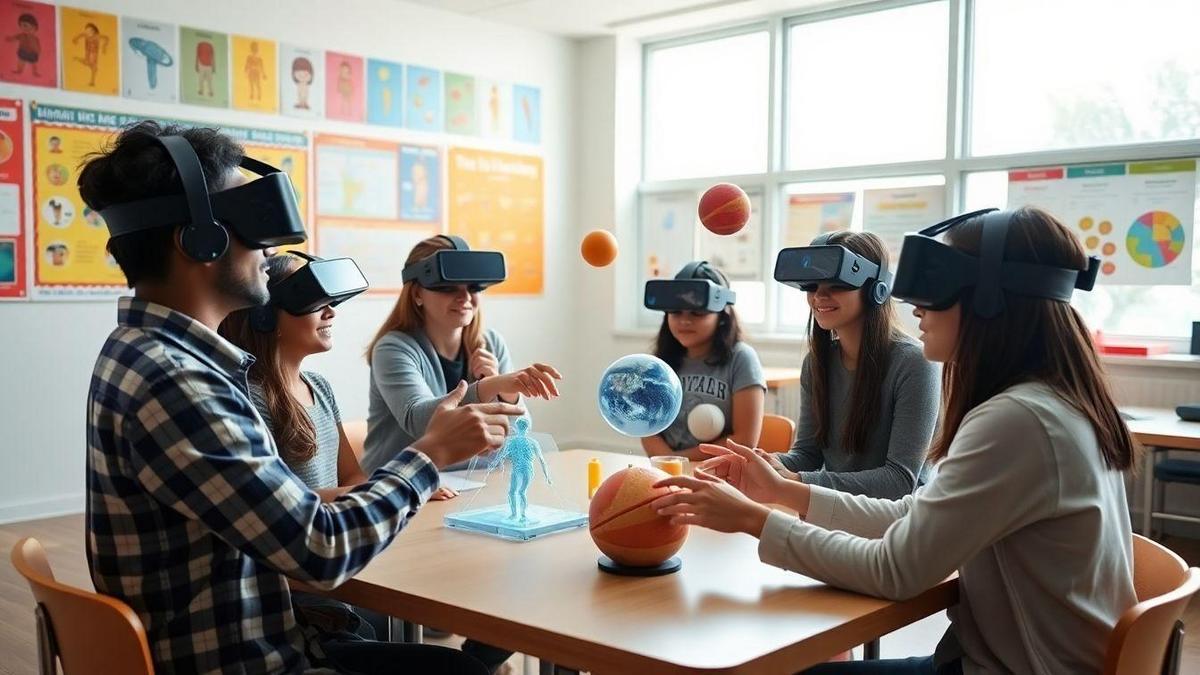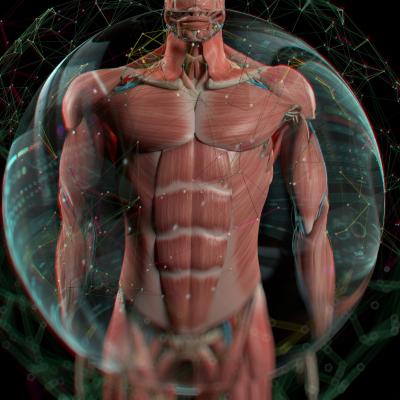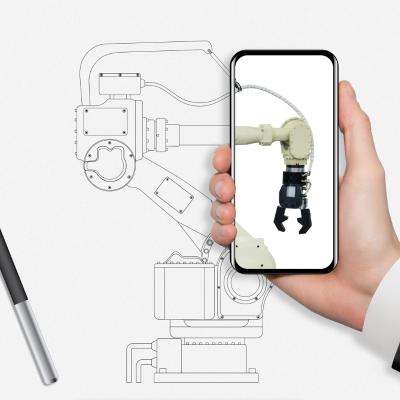Anúncios
Augmented Reality (AR) is transforming the way science is taught in schools and universities. By integrating digital elements into the physical environment, it makes learning more engaging, interactive, and accessible. In science education, this represents a significant leap in how complex concepts are explored.
With the use of mobile devices and specific applications, students can visualize three-dimensional models and real-time simulations. This enhances the understanding of abstract topics and promotes a stronger connection between theory and practice. AR not only motivates students but also reinforces essential skills for the future.
Anúncios

How Augmented Reality Works in Science Education
Augmented Reality (AR) is a technology that overlays digital information onto the real world, enhancing the user’s perception and interaction with their environment. In the context of science education, AR allows students to visualize complex scientific concepts and phenomena in a more engaging and interactive way. The integration of digital elements such as 3D models, animations, and simulations into the physical classroom provides an immersive learning experience that traditional methods often cannot offer. This innovative approach not only captures students’ attention but also encourages active participation in the learning process.
One of the main ways AR functions in science education is through the use of mobile devices and applications designed to recognize specific objects or environments. For example, when a student points their smartphone or tablet at a textbook page or a physical model, the AR application can trigger a digital overlay that displays additional information such as interactive diagrams, videos, or simulations. This immediate access to supplementary content helps students better understand the subject matter by allowing them to visualize and manipulate information in real-time.
In addition, AR can facilitate collaborative learning experiences among students. By working together on AR-based projects, learners can share insights, ask questions, and engage in discussions that deepen their understanding of scientific concepts. This collaborative aspect is particularly beneficial in science education, where teamwork and communication are essential skills. As students explore AR-enhanced materials, they not only gain knowledge but also develop critical thinking and problem-solving skills, which are vital for success in the scientific field.
Besides improving comprehension and collaboration, AR also caters to diverse learning styles. Each student has unique preferences when it comes to absorbing information, and AR offers multiple forms of engagement. Visual learners can benefit from interactive graphics, while kinesthetic learners can explore simulations that allow them to experience scientific principles. By accommodating different learning styles, AR ensures that all students have the opportunity to thrive in their science education.
Advantages of Augmented Reality Applied to Science Education

The advantages of incorporating Augmented Reality into science education are numerous and impactful. One of the main benefits is the ability to create a more engaging and interactive learning environment. Traditional teaching methods often rely on lectures and textbooks, which can lead to passive learning experiences. In contrast, AR encourages active participation, allowing students to interact with content dynamically. This increased engagement can result in better information retention and a deeper understanding of scientific concepts.
Another significant advantage of AR in science education is the improvement of visualization. Many scientific concepts, such as molecular structures or astronomical phenomena, can be challenging to visualize through text alone. AR offers a solution by bringing these concepts to life through 3D models and animations. For example, students can explore the structure of a cell or the solar system in a way that is both informative and visually stimulating. This enhanced visualization helps students grasp complex ideas more easily, making learning more effective.
Moreover, AR promotes experiential learning opportunities that are often difficult to achieve in a traditional classroom setting. With AR, students can conduct virtual experiments, explore simulations, and participate in hands-on activities that reinforce their understanding of scientific principles. This experiential approach not only makes learning more enjoyable but also enables students to apply their knowledge in practical contexts. By bridging theory and practice, AR prepares students for real-world applications of science.
Furthermore, the use of AR in science education can foster inclusion and accessibility. Students with different learning needs or disabilities may face challenges in traditional educational environments. AR can provide personalized experiences that accommodate diverse learners, allowing them to engage with the material in ways that meet their individual needs. For example, visual and auditory cues can be integrated into AR applications to support students with varying levels of understanding. By creating a more inclusive learning environment, AR ensures that all students have equal opportunities for success in science education.
How to Implement Augmented Reality in Science Education
Implementing Augmented Reality in science education requires careful planning and consideration of several factors. The first step is to create interactive AR science experiences that align with the curriculum. Educators should identify specific learning objectives and determine how AR can enhance those goals. This may involve selecting appropriate AR applications or developing custom content that meets their students’ needs. By aligning AR experiences with educational goals, teachers can maximize the impact of this technology on student learning.
Next, educators should utilize AR visualizations to enhance students’ understanding of complex scientific concepts. This can be achieved by incorporating AR tools that provide interactive diagrams, simulations, and 3D models. For example, teachers can use AR apps that allow students to manipulate molecular structures or explore human anatomy in a virtual environment. By providing visual and interactive representations of abstract concepts, AR helps students connect theoretical knowledge with practical applications.
Incorporating virtual labs into the curriculum is another effective way to implement AR in science education. Virtual labs allow students to conduct experiments in a safe and controlled environment, eliminating the risks associated with physical experiments. With AR, students can explore various scientific processes, such as chemical reactions or biological experiments, without the limitations of a traditional lab. This hands-on learning experience not only reinforces theoretical knowledge but also cultivates critical thinking and problem-solving skills.
Additionally, using scientific simulation tools can enhance learning by giving students opportunities to experiment and explore scientific phenomena. AR simulations can replicate real-world scenarios, allowing students to observe and analyze outcomes based on their actions. For example, students can simulate the effects of environmental changes on ecosystems or investigate physics principles through interactive simulations. By engaging in these simulations, students develop a deeper understanding of scientific principles and their practical implications.
Developing engaging science curricula that incorporate AR is essential for successful implementation. Educators should design lessons that seamlessly integrate AR experiences into the curriculum, ensuring that students can easily transition between traditional learning and AR-enhanced activities. This may involve creating lesson plans that outline specific AR applications to be used, as well as providing guidance on how to facilitate discussions and reflections on AR experiences. By carefully integrating AR into the curriculum, teachers can create a cohesive learning experience that maximizes the benefits of this technology.
Finally, exploring educational AR apps can provide educators with valuable resources for immersive educational technology. There are several AR apps available that specifically cater to science education, offering a wide range of content and interactive experiences. Educators should research and evaluate these apps to determine which best meet their students’ needs. By leveraging existing AR resources, teachers can enhance their science education programs and provide students with engaging and interactive learning experiences.
In summary, implementing Augmented Reality in science education involves creating interactive experiences, using visualizations, incorporating virtual labs, using simulation tools, developing engaging curricula, and exploring educational apps. By following these steps, educators can harness the power of AR to transform science education and empower students to become active participants in their learning journey.
Did You Enjoy Learning About Augmented Reality Applied to Science Education?

Exploring augmented reality applied to science education opens exciting possibilities for teachers and students. This innovative approach not only enhances learning but also fosters curiosity and engagement in the sciences. By leveraging AR technology, educators can create dynamic and interactive learning experiences that capture students’ attention and inspire a love for science.
As you dive deeper into this topic, you’ll discover even more ways to integrate AR into educational practices, making science more accessible and enjoyable for everyone. The potential of augmented reality in science education is vast, and as technology continues to evolve, so too will the opportunities to enrich the learning experience for students of all ages.
Frequently Asked Questions
What is augmented reality applied to science education?
Augmented reality applied to science education is a technology that blends the real world with virtual elements, helping to better understand scientific concepts.
How can augmented reality help with science learning?
It brings interactive experiences, allowing visualization of 3D models of cells, planets, and more, making learning more fun and interesting!
What are the benefits of augmented reality in the classroom?
Benefits include greater engagement, better information retention, and development of practical skills. You learn by doing, not just by listening!
Are there specific apps for augmented reality in science education?
Yes, there are several apps. Some let you explore the human body, others help understand chemical reactions. Just download and start learning!
Is augmented reality accessible to all students?
Yes, it can be used on tablets and smartphones, making learning more inclusive and accessible for many students!
